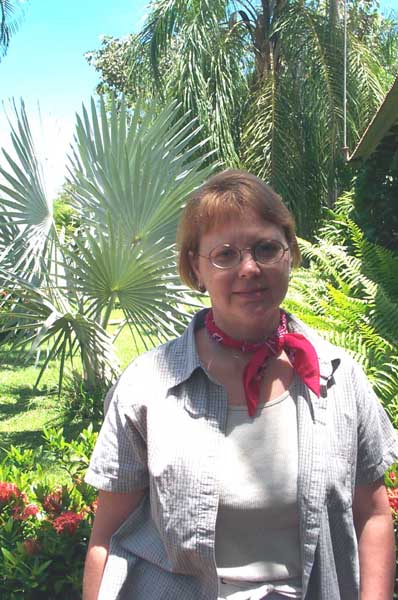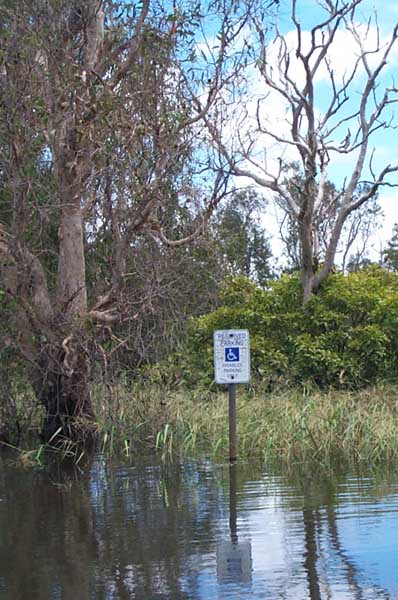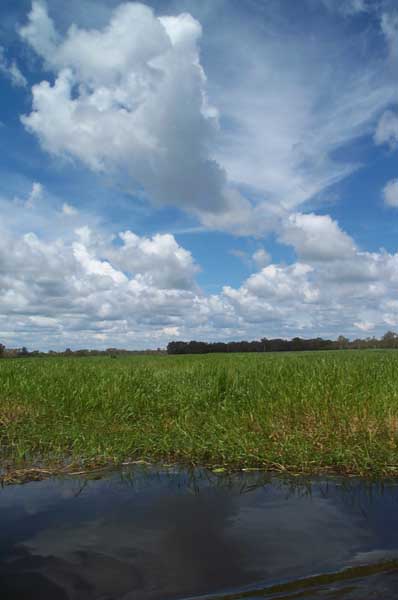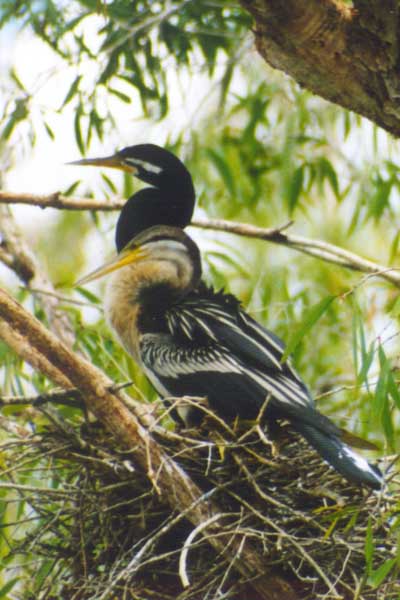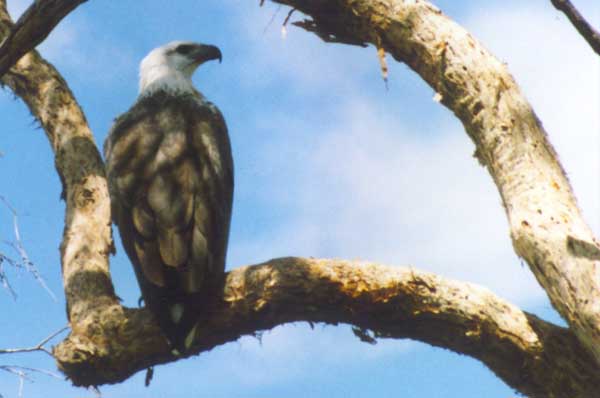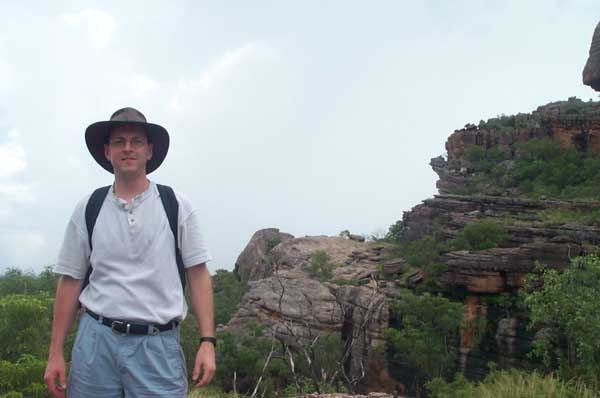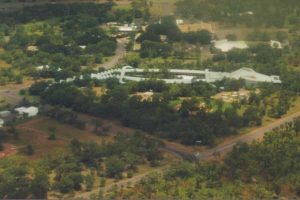We had an early departure from our hotel to begin a tour of Kakadu National Park. We had packed just enough for our three-day excursion into our carry-on bags and checked the big bags at the hotel. By 6:30 we were waiting for our bus. We hadn’t had any breakfast, since the hotel restaurant doesn’t open until 6:30. When the bus was a few minutes late, I dashed into the breakfast room and asked if I could just get a couple of muffins to go. The cashier gave them to me for free, so Chris and I had something to munch on on the bus.
The bus arrived just a few minutes later, and, after about five more pickups, we were on our way with twenty other passengers. The driver informed us that the Arnhem Highway, the most direct highway from Darwin into Kakadu, was under about a meter of water, and was impassable. We would have to take the long route that adds two hours to the trip. While we rode, the driver provided lots of interesting information about Darwin, it’s history, and the Kakadu park. We looked at the scenery going by, seeing lots of tropical trees, tall grass and hundreds of termite mounds. We also saw lots of magpie geese — the park’s most common bird — some large gray birds called brolgas as well as white cockatoos. We caught glimpses of herons, jabirus (a large crane), dingoes and wallabies (a small, round-eared kangaroo).
The tall grass is called spear grass. It grows to heights of six to fifteen feet during the wet season. At the end of the wet season it is left matted and on the ground, posing a significant fire hazard. To prevent wild fires, the Aborigines have developed techniques for burning it off while it is still a little wet, producing controllable, low-temperature fires. They have been creating these burns for tens of thousands of years. All of the plants and animals have adapted to the fires — trees developing tough bark and a tolerance for burns, and animals learning to forage in newly burned areas for barbecued bugs, lizards, etc.
At 11:15 we stopped at the Warradjan Aboriginal Culture center. It has a pretty, but not very informative display of items used by Aborigines in daily bush life. While the display is creatively built — it wanders in a serpentine path — it isn’t very well organized. We felt like we were getting disconnected bits of information without a framework to hang them on. While the information was interesting — like what different spear head shapes are used for, and how the bark of the paper bark tree is used — we didn’t get a big picture of bush life.
At noon we headed a short distance up the road for our lunch, a nice buffet at the restaurant of a small motel. We had time to visit a gift shop and wander around the motel grounds for a while. I lost track of time and was a few minutes late getting back to the bus. From lunch we drove to the Yellow Waters Billabong. A billabong is a water hole that is fed by wet-season flood waters, but doesn’t dry up completely during the dry season. When we were there, at the end of the wet season, there was water everywhere. All of the creeks had overflowed their banks, covered roads, and generally made travel difficult. However, the swollen creeks and extensive flood plains did make boat tours more enjoyable.
At Yellow Waters, we all got onto a pontoon boat and headed out into Jim Jim Creek for a tour.
The tour guide pointed out lots of local trees: mangroves, aquatic pandanus (a bushy palm tree), and various eucalyptus trees. One of the most interesting trees is called the weeping paper bark. The bark of these trees peels off in sheets, and is very soft, flexible, and strong. The Aborigines wrap food in it for cooking, make drinking cups and bowls from it, use it for pillows and mattresses, and even make rafts out of it.
In some areas of the billabong, it is the only tree species that grows, because it has adapted so well to wet and dry conditions. In the autumn, it drops its seeds onto floating grass mats, where the young trees sprout and start to grow. When they get big enough, they weigh the mat down, forcing it to the bottom, where the trees sink roots into the soil. There is a secondary set of roots that stay above the water to keep the tree from drowning.
During our tour we never did see a crocodile. That wasn’t very surprising, since the crocs spread out as much as possible during the flooding. We did see several “logodiles”, logs that get tourists all excited when they think they see a crocodile. We saw nests of Australian darters, a water bird like a cormorant. We also got very close to a sea eagle sitting in a tree by our route. The sea eagle is the top of the bird food chain, eating fish, lizards, small marsupials, and other birds.
The pontoon boat was covered, but some sunshine did come in on the side where I was sitting. I hadn’t bothered to put on sunscreen that day, and, after just an hour of intermittent sun on my right arm and leg, they were pink. The sunburn never developed into anything painful, and I would be careful to keep lots of sunscreen on those areas for the next couple of days.
From Yellow Waters, we drove to Nourlangie Rock, a two-billion year-old sandstone outcropping that is the site of lots of rock art. During the wet season, Aborigines used to come to this rock to take advantage of the many natural over-hangs to get out of the rain. Due to plentiful food, they had lots of free time. They filled this time by telling stories, called “dreamings”, to educate their children and to explain how things came to be. Much of the rock art is thought to have been used to illustrate the dreamings and remind the people of the lessons they had learned there. Some of the pigments last longer than others, red lasting longest — tens of millennia. Yellow and black don’t last as long as red, and white lasts only two or three centuries. Over the millennia, paintings have faded, so new paintings have been made right on top. Most of the time the new paintings were the same as the old ones, but in some cases new art was painted right over old.
Much of the art we saw at Nourlangie was painted in white, making it relatively new, some as recent as 1964. Other paintings appear much older, but no one knows for sure how old any of it is. Some of the paintings are thought to be 17,000 to 20,000 years old based on subject, colors, and style. The amount of new art was disappointing, especially since the tour materials played up the ancient art so much.
The one-day passengers transferred to another bus at Nourlangie, leaving about twelve of us remaining on the bus. Those who left faced a four and one half hour drive back down to the southern end of the park then north to Darwin. The Arnhem Highway across the top of Kakadu was still flooded. The good news for us was that it was expected to be passable by the end of the next day.
From Nourlangie, the bus drove the remaining passengers — the two- and three-day people — back to our hotels. Chris and I stayed in Jabiru at the Gagudju Crocodile Hotel, known for its shape. The building is shaped like a huge crocodile, with reception through the mouth, restaurants and meeting rooms in the head, rooms down the sides and tail, and the swimming pool and gardens in the middle of the body. The legs are used as stairways to get to rooms on the second floor. It has the only restaurant within walking distance, so we made reservations there for dinner when we checked in.
As we settled into our room, Chris said “Listen to those birds!” It was hard not to. There was a cacophony coming from outside that was a continuous stream of shrill shrieks, occasionally interrupted with a much louder series of the same shrieks. We looked out, and the palm trees outside the hotel were crowded with little birds, calling each other. The birds were lorikeets, and they don’t shut up between 6:00 at night and 6:00 in the morning. Inside the room, the shrieks sounded like little plastic crystals being constantly poured into a heap outside our door.
At 7:00 we showed up at the restaurant. Reservations hadn’t been necessary, as there was only one other party there. We got a drink at the bar and chatted with the very friendly bartender. He recommended that we try the kangaroo there, even though we had had it already. I followed his recommendation, and had the best kangaroo I had eaten yet. It was cooked medium rare, very tender, and tasted less like venison than the other times I had had it. It didn’t taste like beef either, but had a very nice flavor not quite like any other meat I’ve eaten. Chris had the barramundi, which she also liked better than at other restaurants.
Our departure the next day was scheduled for 8:00, so we didn’t have to get up quite so early as we had been. However, we were very tired from the early rise that morning, and tumbled into bed by 10:00. The lorikeets were still shrieking, but we quickly got used to the sound, and it didn’t keep us awake.
